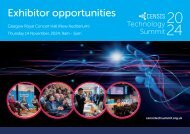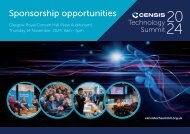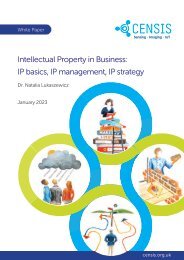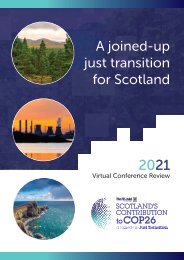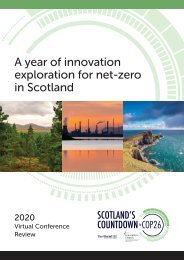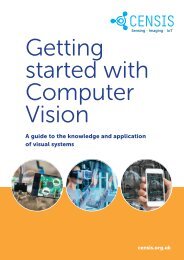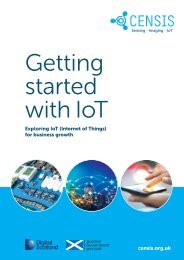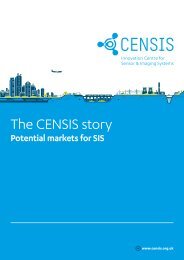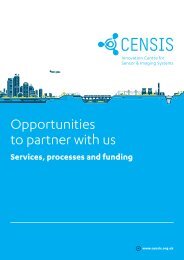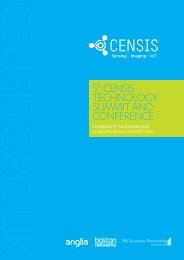CENSIS Review 2013-2016
Create successful ePaper yourself
Turn your PDF publications into a flip-book with our unique Google optimized e-Paper software.
<strong>CENSIS</strong> <strong>Review</strong><br />
<strong>2013</strong> – <strong>2016</strong><br />
www.censis.org.uk
Bob Downes<br />
<strong>CENSIS</strong> Chairman<br />
“A great deal has been<br />
accomplished and this<br />
review showcases the<br />
many ways in which we are<br />
helping businesses with<br />
their sensor and imaging<br />
systems challenges.”<br />
Bob Downes<br />
<strong>CENSIS</strong> Chairman<br />
Welcome<br />
I am pleased to introduce this overview of some<br />
of the activities that have taken place at <strong>CENSIS</strong><br />
since the Innovation Centre was founded in <strong>2013</strong><br />
with the support of the Scottish Funding Council,<br />
Scottish Enterprise and Highlands and Islands<br />
Enterprise. A great deal has been accomplished<br />
and this review showcases the many ways in<br />
which we are helping businesses with their<br />
sensor and imaging systems challenges.<br />
Mirage, our largest strategic research project to date is a £6M private-public<br />
sector investment in the development of compound semiconductor platform<br />
technologies that will see key skilled jobs and technologies being created<br />
in Scotland. Other highlights include the IoT Centre, formed in response to<br />
industry requests to support the rapid development of end-to-end sensor<br />
systems solutions using IoT technologies. You will also read about our latest<br />
large-scale initiative, the LoRa IoT network, developed in conjunction with<br />
industry partners and public sector organisations across Scotland to help<br />
generate even wider business growth.<br />
This review features highlights of innovative projects that have been<br />
generated with the support and knowhow of the <strong>CENSIS</strong> team. The projects<br />
are extremely diverse, covering everything from environmental risk<br />
monitoring and management to rail track maintenance; and from subsea<br />
systems to pharmaceuticals. However, the common element they all share<br />
is that <strong>CENSIS</strong> is helping to overcome the significant practical challenges<br />
involved in taking innovation to the marketplace. One of our key strengths<br />
is our ability to deliver Technology Readiness Level (TRL) uplift with our<br />
collaborative projects and we work very hard to help companies and their<br />
academic partners tackle the ‘valley of death technology gap’. At <strong>CENSIS</strong>,<br />
I am very proud to say that the majority of projects we support bridge this<br />
gap, with most starting at TRL 3 and finishing at TRL 6.<br />
As an industry-led innovation hub for intelligent sensor systems, <strong>CENSIS</strong><br />
has at its heart the values, expertise and experience needed to support<br />
business growth and strengthen economic development in Scotland. Our<br />
knowledge of the technical and research landscape continues to grow<br />
and our developing strengths have helped us to break new ground and<br />
strengthen existing Scottish supply chains.<br />
I want to especially thank all of our stakeholders and partners for their<br />
support and I look forward to bringing you all further updates on our<br />
progress in the years to come.<br />
Page 2
<strong>CENSIS</strong> <strong>Review</strong> <strong>2013</strong> – <strong>2016</strong><br />
“It is fantastic to see how<br />
<strong>CENSIS</strong> is succeeding<br />
in gaining mindshare in<br />
Scotland. Your ventures<br />
into IoT are an exciting<br />
area of collaboration and<br />
I look forward to this<br />
continuing and building<br />
on the relationships that<br />
we’ve developed with the<br />
<strong>CENSIS</strong> team to date.”<br />
Douglas McGarrie<br />
CTO IBM Scotland<br />
Contents<br />
Sensing Opportunities for Scotland ......................... 4<br />
Project and Activity Highlights ................................. 8<br />
Making an Impact ................................................... 14<br />
Page 3
IoT Centre<br />
“We had great help from<br />
the IoT Centre team with<br />
selecting the technology<br />
and providing proof of<br />
concept code. Being able<br />
to hot desk for one or two<br />
days a week in <strong>CENSIS</strong><br />
is very useful to allow<br />
development work to be<br />
carried out away from dayto-day<br />
interruptions. We<br />
believe that there could<br />
be significant gains to be<br />
had with get-togethers<br />
with other like-minded<br />
companies – using <strong>CENSIS</strong><br />
as a hub to promote<br />
knowledge transfer and to<br />
encourage innovation.”<br />
John Ashley<br />
Technical Services Manager,<br />
FUELlink Systems<br />
Sensing Opportunities<br />
for Scotland<br />
Fast-tracking IoT solutions: the IoT Centre<br />
The IoT Centre is a facility within <strong>CENSIS</strong> to help businesses overcome many of the<br />
challenges they face in product development around the Internet of Things (IoT) and<br />
is designed to help businesses – normally SMEs – take an IoT product from concept to<br />
prototype in a fraction of the time normally required.<br />
There are different levels of engagement<br />
available depending on the individual need:<br />
n Access to a complete suite of<br />
development devices and software from<br />
world-leading vendors; everything from<br />
hardware to cloud storage<br />
n Stress testing and validation of ideas<br />
n Hot desk space<br />
n Mentoring and support from a skilled<br />
industry-experienced team of hardware,<br />
IoT Centre ‘graduates’ already include:<br />
software and firmware engineers with<br />
50+ years’ collective experience<br />
n The Urban Farming Company<br />
n Connection to <strong>CENSIS</strong>’ professional<br />
n OBrand Communications<br />
networks<br />
n FUELlink Systems<br />
n A professional, high spec demonstration n Sensor-Works<br />
area to showcase products to potential<br />
n Sansible Wearables<br />
investors.<br />
Mirage<br />
“This project is an<br />
excellent example<br />
of how collaborative<br />
working can support<br />
the development of<br />
advanced manufacturing<br />
technologies, boosting<br />
productivity and driving<br />
growth. Innovation<br />
Centres have a unique role<br />
to play in engaging with<br />
businesses to identify new<br />
solutions and we would<br />
like to see more of these<br />
types of projects develop<br />
in the future.”<br />
John Swinney MSP<br />
Deputy First Minister<br />
of Scotland<br />
Page 4<br />
Mirage: Enhancing Scotland’s global<br />
sensor capabilities<br />
This groundbreaking project will place<br />
Scotland at the forefront of the £7 billion<br />
global sensors and imaging systems market,<br />
deliver significant economic growth and<br />
onshore 41 highly skilled research and<br />
manufacturing jobs from Asia. The project is<br />
expected to deliver £56 million to the Scottish<br />
economy over the next 10 years and will give<br />
the companies involved a critical competitive<br />
edge in the global mid-IR sensors market.<br />
The project, backed by Scottish Enterprise<br />
and <strong>CENSIS</strong>, will provide the organisations<br />
involved with unique access to III-V<br />
semiconductors, allowing them to create<br />
cutting-edge, quality mid-IR sensors in high<br />
volumes with greater sensitivity, lower cost,<br />
reduced energy use and a longer lifespan than<br />
existing products. These can be employed<br />
in a wealth of applications including: thermal<br />
imagers, building management, vehicle safety<br />
(CO 2<br />
) and pollution expertise.<br />
Bringing significant production capability<br />
back to the UK allows us to innovate much<br />
more quickly. Access to these materials and<br />
the technology used to produce them will<br />
develop Scotland’s technical skills in advanced<br />
sensors and imaging systems. Further<br />
innovation and engineering breakthroughs<br />
are expected via continuing collaborative<br />
research and sharing of expertise.
<strong>CENSIS</strong> <strong>Review</strong> <strong>2013</strong> – <strong>2016</strong><br />
LoRa: Paving the way for the Internet of Things<br />
boston<br />
networks<br />
By 2020, it is estimated that there will be 20Bn<br />
connected devices in the world requiring IoT<br />
networks. The major growth sector in the<br />
IoT solutions market - valued in the trillions<br />
of dollars - will be small, autonomous devices<br />
servicing new business and information<br />
models and covering every area of our lives<br />
– from smart cities and smart homes (think<br />
street lights to refuse collection to home<br />
appliances), to precision agriculture and food<br />
production, industrial automation, asset<br />
tracking and wearable devices.<br />
LoRa is an embedded wireless networking<br />
standard to support IoT. The technology<br />
addresses the demands presented by ever<br />
increasing numbers of connected devices<br />
by offering long-range connectivity and<br />
low power operation, with a low cost that<br />
avoids the need for complex installations<br />
and supports high volume deployment.<br />
This combination will be transformative in<br />
enabling IoT connectivity to new types of<br />
devices and applications as well as enabling<br />
and delivering new business solutions.<br />
<strong>CENSIS</strong> is a member of the LoRa Alliance,<br />
a non-profit organisation focused on<br />
standardising LoRa and creating a strong<br />
ecosystem to scale the technology, and<br />
began a roll out of LoRa projects across<br />
Scotland in the summer of <strong>2016</strong> that include:<br />
Glasgow: across City Centre,<br />
Merchant City, West End<br />
<strong>CENSIS</strong>, Stream Technologies,<br />
Semtech, Boston Networks<br />
In conjunction with the University of Glasgow,<br />
University of Strathclyde and Glasgow<br />
Caledonian University, the network enables<br />
the development and use of devices such as<br />
building and indoor environmental monitors,<br />
pollution sensors, tags for tracking valuable<br />
assets and social care devices designed to<br />
support independent living.<br />
Features of the Glasgow city network are:<br />
n Ubiquitous connection within the city<br />
n 5-year battery life potential<br />
n Location determination without<br />
power drain<br />
In addition to its attractiveness for use<br />
case development, Glasgow was selected<br />
as the development location for LoRa<br />
technology because of its similarities to<br />
many major metropolitan areas worldwide.<br />
Glasgow includes a grid system like major<br />
US conurbations, older historic spaces and a<br />
mix of urban and extra-urban environments<br />
– all of which are ideal for testing lowpower<br />
radio network performance.<br />
Inverness: An Lòchran campus<br />
<strong>CENSIS</strong>, Stream Technologies,<br />
SPICA Technologies<br />
The partners have installed 50 LoRa<br />
connected sensors as part of An Lòchran,<br />
a new £13-million business hub shared<br />
by Highlands and Islands Enterprise, the<br />
University of the Highlands and Islands, and<br />
Scotland’s Rural University College.<br />
The devices will monitor temperature,<br />
humidity, noise, CO 2<br />
and light with the aim<br />
of delivering greater efficiencies and energy<br />
savings in the building and optimise the<br />
working environment. By generating a new<br />
innovation flow in the Highlands, LoRa will<br />
also give businesses access to emerging IoT<br />
technologies and can support companies<br />
in developing new products and services.<br />
Additionally, the system shows the art of<br />
the possible and acts as a bridgehead for<br />
<strong>CENSIS</strong> support and is part of our future<br />
geographical inclusion model.<br />
LoRa<br />
“This has the potential<br />
to be as disruptive to<br />
businesses as the internet<br />
has been already to daily<br />
life – and Scotland is at<br />
the forefront of making<br />
that happen.”<br />
Dr Mark Begbie<br />
Business Development<br />
Director, <strong>CENSIS</strong><br />
Page 5
IoTUK Boost<br />
Feedback from<br />
participants<br />
“Genuinely the last two<br />
days were the most useful<br />
I have had in the last six<br />
months.”<br />
Dane Ralston<br />
Losstek<br />
“Congratulations on a<br />
fabulous IoT UK Boost<br />
event. It was intense...<br />
as they say. A job well<br />
done – please pass on my<br />
thanks to the rest of your<br />
team. Really enjoyed the<br />
networking, the sessions<br />
and yes, even the pitching.<br />
It certainly generated a<br />
great ‘community’ and<br />
supportive atmosphere<br />
and from my side, it was<br />
great to catch up with<br />
some familiar faces, meet<br />
new ones and make some<br />
really useful connections.”<br />
Michael Groves<br />
Topolytics<br />
“I wanted to say that this<br />
particular format is by far<br />
the best, in my opinion.<br />
I think the areas the<br />
speakers covered, and the<br />
Innovation Centres being<br />
present, it adds good<br />
value to starting SMEs.<br />
Thanks for giving us the<br />
opportunity to be part of it.”<br />
Trias Gkikopoulos<br />
Eaglei Systems<br />
Sensing Opportunities<br />
for Scotland<br />
Supporting Scotland’s IoT<br />
innovators<br />
IoTUK Boost Competition<br />
Workshop<br />
<strong>CENSIS</strong> was selected as one of four regional partners for the IoTUK Boost initiative, a<br />
programme designed to convene and amplify the UK’s IoT industry to help business and<br />
economic growth.<br />
Hosted by <strong>CENSIS</strong> in conjunction with The Data Lab and Informatics Ventures, 18 SMEs<br />
were selected to attend a workshop in February <strong>2016</strong>. At the end of two days, participants<br />
pitched their business plan to a panel of expert judges. Five were selected to progress to<br />
a month’s worth of incubation support and mentoring to help them in the first stages of<br />
bringing their commercial idea to market.<br />
IoTUK Boost winners were:<br />
n Sansible Wearables (also<br />
awarded ‘One to Watch’ award<br />
by IoTUK, allowing the company<br />
to pitch to investors at the<br />
international BLN IoT Forum <strong>2016</strong>)<br />
n FUELlink Systems (product<br />
expected in market November <strong>2016</strong>)<br />
n OBrand Communications<br />
n Rapport Network<br />
n The WindOP<br />
Page 6
<strong>CENSIS</strong> <strong>Review</strong> <strong>2013</strong> – <strong>2016</strong><br />
A quiet revolution in a Scottish forest<br />
TV White Space (TVWS)<br />
boston<br />
networks<br />
According to Ofcom’s latest data, most of the UK still only receives the lowest level of 3G<br />
coverage, and in a country with Scotland’s topography that can be a major challenge –<br />
particularly for tourist destinations which are often in remote locations.<br />
In May 2015, <strong>CENSIS</strong> carried out a successful pilot project to bring an emerging networking<br />
approach - TV White Space (TVWS) – to the Enduro World Series mountain biking<br />
competition at Glentress in the Scottish Borders, allowing the event organisers to provide<br />
and make use of live video streaming, increased access to data and enhanced automation<br />
for its staff and spectators.<br />
This breakthrough for connectivity gave the project partners a unique opportunity to gain<br />
an early lead with the technology, which is on the cusp of widespread adoption. Significant<br />
progress is now being made on introducing this technology across the world, in both<br />
mature and emerging markets, thanks in part to such demonstrator projects.<br />
Sensing the city<br />
Low-cost mobile sensor network for air quality<br />
Organisations responsible for monitoring urban air quality currently gather most of their data<br />
from fixed monitoring stations. While these are very accurate, they are expensive, costly to<br />
maintain, and do not provide a detailed picture of what is happening across the city, e.g., what<br />
is the air quality like a few streets away from the fixed station? Currently, modelling techniques<br />
have to be used to build the bigger picture.<br />
In partnership with the University of Strathclyde’s Institute for Future Cities, <strong>CENSIS</strong> has<br />
developed a flexible low cost and low power mobile sensor system designed to supplement –<br />
and complement – these static base stations.<br />
A pilot project in spring <strong>2016</strong> saw the system installed on some of the University of<br />
Strathclyde’s fleet of vans, providing near real-time air quality data from wherever the vehicle<br />
was located. An interactive web-based user dashboard visualised the data, allowing interaction<br />
with the cloud services and supporting the capabiliity to embed data processing and analytics<br />
outputs as these are developed. The system is also capable of gathering data in the volume<br />
and with the rapidity required to support model comparison and to identify trends.<br />
Future plans for the project are to grow coverage, introduce analytics, extend communication<br />
protocols and optimise sensor detection sensitivity. The project is also moving to trial with<br />
Transport Scotland.<br />
Modern farming: the Agricultural Engineering<br />
Precision Innovation (Agri-EPI) Centre<br />
TV White Space<br />
“The results of this quiet<br />
revolution could have<br />
incredible consequences<br />
for many of the country’s<br />
remote tourist attractions<br />
– TV White Space could<br />
connect them with the<br />
rest of the world for the<br />
first time.”<br />
Ian Reid<br />
CEO, <strong>CENSIS</strong><br />
Science of<br />
Sensor Systems<br />
Software (S4)<br />
The Universities of Glasgow<br />
and St Andrews, along with<br />
Liverpool University and Imperial<br />
College London, are to share<br />
£4.2M from the Engineering<br />
and Physical Sciences Research<br />
Council (EPSRC) to investigate<br />
the delivery of more reliable<br />
sensor-based systems and the<br />
decisions they support, for<br />
example: the development<br />
of water networks, air quality<br />
monitoring, autonomous driving<br />
and advanced manufacturing.<br />
<strong>CENSIS</strong>, in its support of the<br />
programme, will work with<br />
the universities and the sensor<br />
systems community to identify<br />
challenges, develop collaborative<br />
projects, and provide access to<br />
expertise and resources.<br />
By 2020, precision agriculture is set to be worth £2.3 billion globally. Amidst this revolution,<br />
the Agri-EPI Centre has been established to ensure the UK increases its status as one of the<br />
world leaders in the sector. Initial areas of interest for the Centre include automated vehicles,<br />
unmanned aerial vehicles, instrumentation to monitor operations and performance of cropping<br />
systems, as well as sensing and imaging technologies to monitor crop and livestock production.<br />
As Agri-EPI members, <strong>CENSIS</strong> will deliver LoRa LPWAN connectivity to a number of farms<br />
initially, with extension to aquaculture sites in the longer term. We will use this to support the<br />
development, deployment and evaluation of new sensing and monitoring approaches. These<br />
will increase yield, support lowered costs and improve husbandry standards.<br />
Page 7
Project and<br />
Activity Highlights<br />
Aecom<br />
With UK Astronomy Technology Centre<br />
Hyperspectral imaging (HSI) data from satellites is routinely used to monitor oceans and<br />
large bodies of inland water. It is as yet unproven however in the field of shallow and narrow<br />
waterways.<br />
AECOM and UK ATC worked together to lay the basis for the development of next<br />
generation compact and portable HSI imagers and data analytics tailored to monitoring<br />
confined water bodies.<br />
Amethyst Research<br />
With University of Dundee<br />
New uses for infra-red spectroscopy and infra-red cameras were explored in this project, to<br />
identify biological and chemical deposits which otherwise could be difficult to see.<br />
The three month long project demonstrated the significant benefit infra-red imaging technology<br />
could bring within the field of crime scene investigation to identifying relevant evidence.<br />
Biogelx<br />
With University of Strathclyde<br />
This project aims to develop a bio-imaging platform that can perform accurate, live,<br />
intracellular analysis of cells in 3D.<br />
The most prominent market segment where live intracellular imaging is key is stem cell<br />
research, which will impact areas such as tissue engineering and cell therapy.<br />
With a focus on monitoring stem cells, this platform can address the need for both improved<br />
cell-imaging capabilities, whilst ensuring the cells are grown in a tissue-like environment<br />
using sophisticated hydrogel technology.<br />
Page 8
<strong>CENSIS</strong> <strong>Review</strong> <strong>2013</strong> – <strong>2016</strong><br />
Cascade Technologies<br />
With University of Glasgow<br />
The aim of this project was to address the high-level challenge of developing, safe, reliable<br />
and cost-effective technologies for the emerging shale gas market.<br />
The team developed and demonstrated a network of open path gas sensing platforms<br />
capable of continuous and remote operation to localise and monitor fugitive emissions of<br />
gases from unconventional extraction sites.<br />
Findlay Irvine<br />
With Heriot-Watt University<br />
This collaboration explored a new sensor system to measure voids under railway sleepers as<br />
trains pass. Deploying wireless accelerometers directly to railway track infrastructure allows<br />
for the real time monitoring of railway track movements during train passage.<br />
Although signal processing challenges have previously prevented the development of<br />
such a commercial product, a new algorithm has the potential to overcome these and be<br />
expanded to measure railway voiding.<br />
Gas Sensing Solutions<br />
With Glasgow Caledonian University<br />
The investigation of intelligent sensor systems with applications for the built environment,<br />
telehealthcare and the oil and gas industries was the challenge for this project. The team<br />
investigated the possibilities of smart Sensors as embedded intelligent self-learning<br />
systems. This would allow sensors to anticipate and respond to changing conditions with<br />
minimal human intervention, helping to provide comfortable living environments, reduce<br />
power consumption and protect the environment.<br />
Gas Sensing Solutions and Wideblue<br />
With the University of the West of Scotland<br />
GSS also collaborated on a project with Wideblue and the University of the West of Scotland<br />
on the feasibility of a portable respiratory device for sports and exercise.<br />
The team aimed to establish measured and modelled performance data and provide a go/<br />
no go decision as to feasibility for using the new Wideblue/GSS medical capnometers in<br />
exercise science and recreational sports applications.<br />
Page 9
Hydrason Solutions<br />
With Heriot-Watt University<br />
This project (WACEMM) investigated how the capabilities of Hydrason’s Wideband Sonar<br />
system (WBS) could be further enhanced to improve its performance.<br />
The WBS system can accurately locate an underwater object and identify its structure and<br />
composition without making any direct contact. This is useful in areas such as subsea or<br />
coastal surveying, asset and integrity management, and flow assurance.<br />
The project aimed to further improve underwater object recognition performance, allowing<br />
even greater environmental, seabed and structural detail.<br />
ICT Innovation for Manufacturing<br />
SMEs (I4MS)<br />
With the Advanced Forming Research Centre, part of the UK’s High<br />
Value Manufacturing Catapult and Scottish Enterprise<br />
This EU initiative aims to build a network of Regional Digital Manufacturing Innovation<br />
(RDMI) hubs; helping companies plan and prepare for the introduction of advanced digital<br />
manufacturing processes (known as Industry 4.0).<br />
The partnership is supporting a six-month feasibility study to examine the business case<br />
for the establishment of a Scottish RDMI hub. <strong>CENSIS</strong>’s role involves developing the supply<br />
chain of SMEs in the SIS space that can bring expertise to the growing digital manufacturing<br />
ecosystem.<br />
Innovent Technology<br />
With University of Strathclyde and National Physical Laboratory (NPL)<br />
This collaboration investigated the feasibility of a scanning technique to measure the depth<br />
of back fat on live animals. The developed instrument and methodology will enable more<br />
accurate indication for back fat, improving management and nutrition, lowering production<br />
costs and increasing the selection accuracy of animals for slaughter.<br />
The proposed new system could provide an alternative to existing ultrasound livestock back<br />
fat scanners that require direct contact with the skin to produce effective measurements.<br />
Page 10
<strong>CENSIS</strong> <strong>Review</strong> <strong>2013</strong> – <strong>2016</strong><br />
Optos<br />
With University of Glasgow<br />
Optos has carried out two <strong>CENSIS</strong> projects. The first explored the correction of optical<br />
aberrations for improved image quality in Optos scanning laser ophthalmoscopes.<br />
An additional project aimed to enhance the Optos QA process through the development<br />
and implementation of an automated image artefact detection scheme that will flag<br />
potential faults during the manufacturing process.<br />
Offshore Renewable Energy (ORE) Catapult<br />
This collaborative project with <strong>CENSIS</strong> delivered a review of the state-of-the-art sensors<br />
and imaging systems for detecting the presence of marine mammals in the vicinity of tidal<br />
turbines.<br />
The review identified current practice in tidal turbine collision risk technologies and<br />
explored where existing systems could be improved and further optimised.<br />
Renishaw<br />
With Heriot-Watt University<br />
Using Low Temperature Co-fired Ceramic (LTCC) technology, this project aimed to design,<br />
manufacture and test a cutting edge yet robust magnetic transducer system.<br />
Today’s magnetic transducers of this type are largely based on planar 2D sensing coils. This<br />
project investigated the development of a 3D transducer using low-cost LTCC technology.<br />
SMS Oilfield<br />
With Robert Gordon University<br />
Many of the world’s oil and gas reserves are contained in sandstone reservoirs. Sand’s<br />
abrasive impact can erode flow lines and lead to clogged production equipment.<br />
By exploring improved data analytics and algorithms for sand monitoring, this activity is<br />
looking at ways in which to enable real-time intelligent management of sand in production<br />
flow, with the aim of improving safety and overall equipment effectiveness, improving the<br />
productivity of onshore and offshore operations and reducing intervention costs.<br />
Page 11
Scottish Water<br />
With University of Strathclyde<br />
Scottish Water holds and gathers vast data sets relating to water and wastewater pumping<br />
stations and their related operating environments. Pumps are often deployed in remote<br />
and demanding environments, where failure can impact quality of service and repairs<br />
can be costly and time consuming. By investigating techniques to identify key signatures<br />
within large volumes of sensor-derived data, the project aimed to allow the organisation to<br />
optimise the performance of its equipment in the field.<br />
Thales UK Glasgow<br />
With University of the West of Scotland<br />
The challenge of this collaboration was to develop an algorithm that can process lowresolution<br />
infrared imagery to recognise vehicles and humans, and identify the vehicle’s<br />
type in real time with limited processing hardware. The developed algorithm contains two<br />
key elements: (i) advanced image restoration and (ii) automatic detection and recognition.<br />
Topolytics<br />
With University of St Andrews<br />
TM<br />
This is a collaborative pilot project with Topolytics, the University of St Andrews, CalaChem,<br />
Air Monitors Ltd and the Scottish Government.<br />
Incorporating the university’s statistical models into Topolytics software will help identify<br />
and eliminate many of the false positives that can crop up. This will enhance decisionmaking<br />
by allowing users to better understand and have more confidence in data produced<br />
by environmental sensors.<br />
Page 12
<strong>CENSIS</strong> <strong>Review</strong> <strong>2013</strong> – <strong>2016</strong><br />
A review of <strong>CENSIS</strong> activity<br />
<strong>2013</strong>-<strong>2016</strong><br />
Project portfolio: maturing TRLs<br />
No. of projects<br />
16<br />
14<br />
Project Start TRL<br />
Project Finish TRL<br />
12<br />
10<br />
8<br />
6<br />
4<br />
2<br />
0<br />
0<br />
-2<br />
1 2 3 4 5 6 7 8 9<br />
TRL Level<br />
Current project portfolio<br />
£12.5m<br />
Current GVA up to<br />
£82m<br />
Project sectors<br />
Industrial and<br />
Manufacturing<br />
Natural and Built<br />
Environment<br />
Subsea, Offshore<br />
and Marine<br />
Health, Wellbeing<br />
and Life Sciences<br />
Defence<br />
CBNRE<br />
<strong>CENSIS</strong> assets<br />
IoT Centre<br />
LoRa<br />
Digital Subsea<br />
/Offshore<br />
<strong>CENSIS</strong> international reach<br />
<strong>CENSIS</strong> community<br />
Germany<br />
Spain<br />
China<br />
Japan<br />
Berlin<br />
Munich<br />
Barcelona<br />
Madrid<br />
Zaragoza<br />
Chongqing<br />
Shanghai<br />
Tokyo<br />
1350+<br />
We have over<br />
1350 followers<br />
on Twitter<br />
@<strong>CENSIS</strong>121<br />
3500+<br />
There are over<br />
3500 companies,<br />
universities<br />
and research groups<br />
in our database.<br />
1250+<br />
Events attended<br />
or organised by<br />
<strong>CENSIS</strong> staff.<br />
Page 13
Making an Impact<br />
The Innovation Centres in Scotland<br />
As part of <strong>2016</strong>’s Year of Innovation Architecture and Design, Scotland’s<br />
eight Innovation Centres came together to celebrate Scottish innovation.<br />
Activity centred around a showcase event in June, TEDxGlasgow. Exploring the theme of ‘A<br />
disruptive world’ and attracting over 1000 delegates, TEDxGlasgow was one of a worldwide<br />
group of conferences in the TED (Technology, Entertainment, Design) family that offers<br />
‘Ideas worth spreading’.<br />
On the day, delegates were introduced to ‘Innovation Avenue’, the ICs’ tailor made<br />
interactive exhibition<br />
that explored a range of<br />
technologies associated<br />
with the different Centres.<br />
This was supplemented<br />
by exploratory workshops<br />
around the subject of the<br />
future of Scottish innovation.<br />
TEDx also saw the launch of the<br />
Centres’ joint website<br />
www.innovationcentres.scot<br />
featuring the new IC video.<br />
Page 14
<strong>CENSIS</strong> <strong>Review</strong> <strong>2013</strong> – <strong>2016</strong><br />
Meeting future innovators<br />
As well as our annual Technology Summit and Conference which has taken<br />
place in both Edinburgh and Glasgow, the <strong>CENSIS</strong> team organises events,<br />
attends exhibitions and also speaks at relevant seminars throughout Scotland.<br />
Page 15
Contact details:<br />
<strong>CENSIS</strong><br />
The Inovo Building<br />
121 George Street<br />
Glasgow<br />
G1 1RD<br />
Tel: 0141 330 3876<br />
Email: info@censis.org.uk<br />
Join the <strong>CENSIS</strong> mailing list at www.censis.org.uk<br />
Follow us on Twitter<br />
<strong>CENSIS</strong>121




